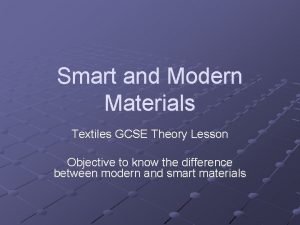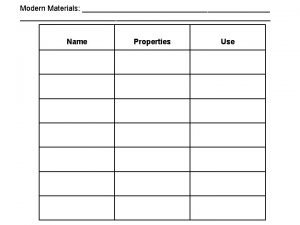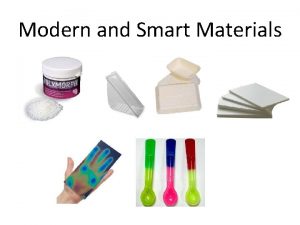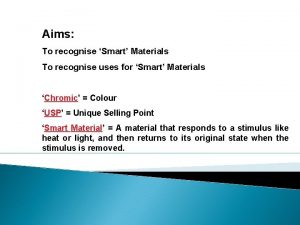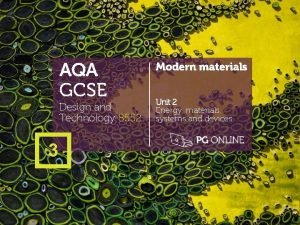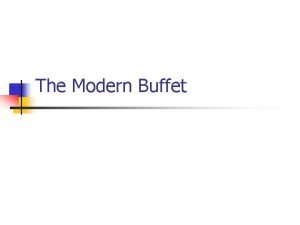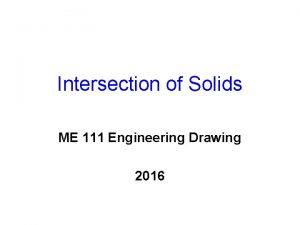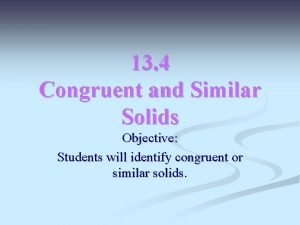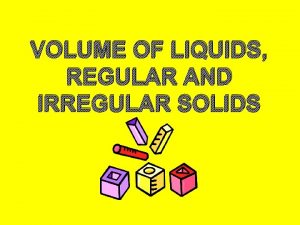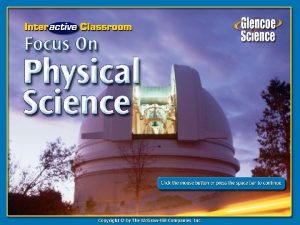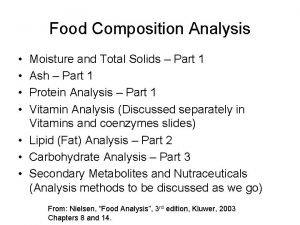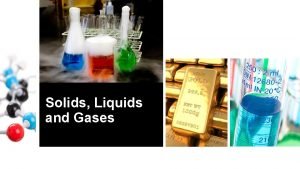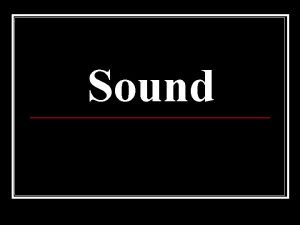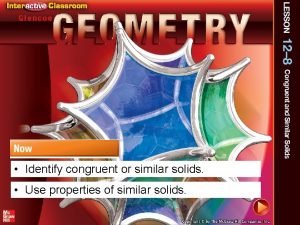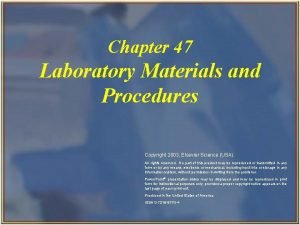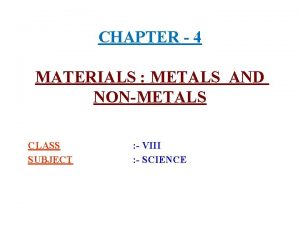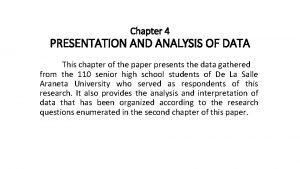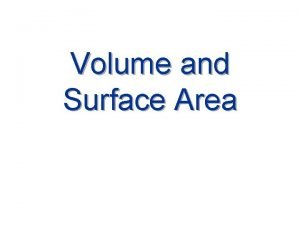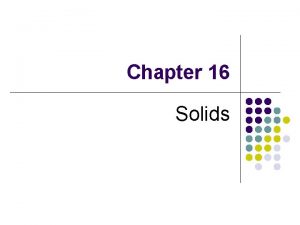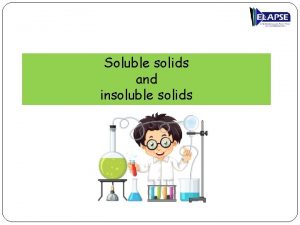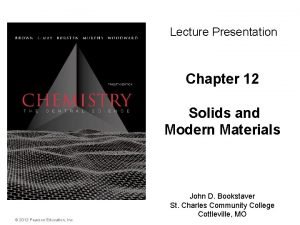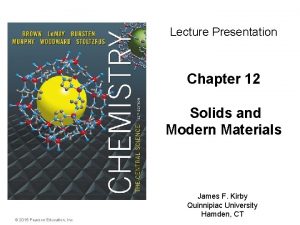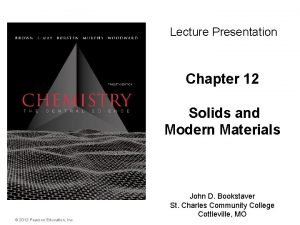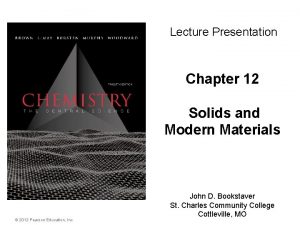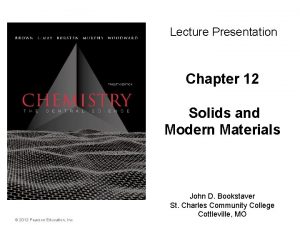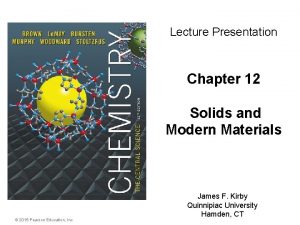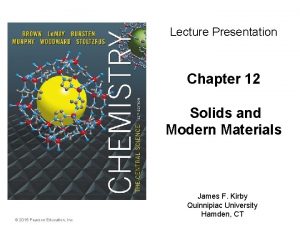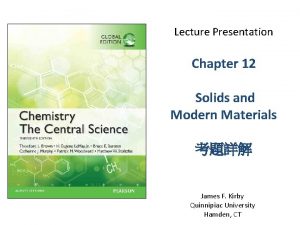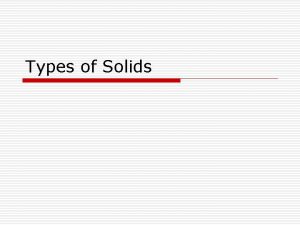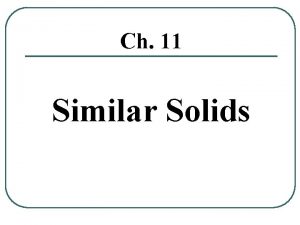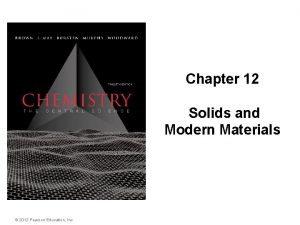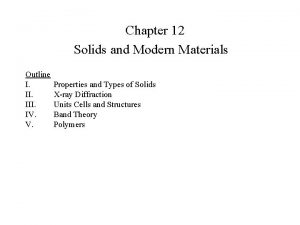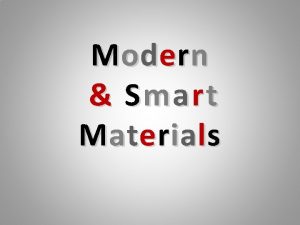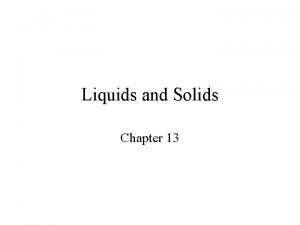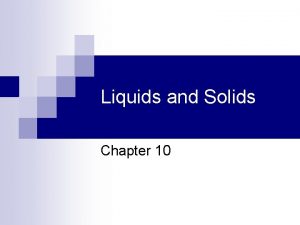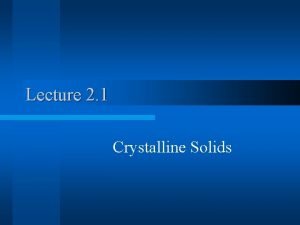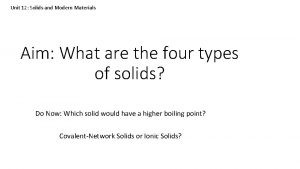Lecture Presentation Chapter 12 Solids and Modern Materials




















































- Slides: 52

Lecture Presentation Chapter 12 Solids and Modern Materials © 2015 Pearson Education, Inc. James F. Kirby Quinnipiac University Hamden, CT

Classifying Solids Based on Bonds 1) Metallic solids are held together by a “sea” of collectively shared electrons. Ø This type of bond allows metals to conduct electricity Ø Metals are relatively strong without being brittle 2) Ionic solids are sets of cations and anions mutually attracted to one another. Ø Do not conduct electricity well Ø They are brittle © 2015 Pearson Education, Inc. Modern Materials

Classifying Solids Based on Bonds 3) Covalent-network solids are joined by an extensive network of covalent bonds. Ø Some are extremely hard (diamonds) Ø Some are semiconductors Ø Examples: diamond, graphite, and silicon dioxide 4) Molecular solids are discrete molecules held together by intermolecular forces. Ø Tend to be soft with low melting points © 2015 Pearson Education, Inc. Modern Materials

Two Other Types of Solids 1) Polymers contain long chains of atoms connected by covalent bonds; the chains can be connected to other chains by weak forces. § Normally stronger and higher melting points than molecular solids § More flexible than metallic, ionic, and covalent-network solids Modern Materials © 2015 Pearson Education, Inc.

2) Nanomaterials are crystalline compounds with the crystals on the order of 1– 100 nm; this gives them very different properties than larger crystalline materials. § nanofibers, nanowires, nanotubes, etc Modern Materials © 2015 Pearson Education, Inc.

One Organization of Solids • Solids with a regular repeating pattern of atoms are crystalline. • Amorphous solids are characterized by a distinct lack of order in the arrangement of atoms. • Since crystalline solids have a regular pattern, they are of more interest to most chemists. © 2015 Pearson Education, Inc. Modern Materials

Unit Cell • The basis of a repeating pattern is the unit cell. • The structure of a crystalline solid is defined by Ø the size and shape of the unit cell. Ø the locations of atoms within the unit cell. lattice point © 2015 Pearson Education, Inc. At lattice points: • Atoms • Molecules • Ions Modern Materials

Lattice Points • Positions that define the overall structure of the crystalline compound are called lattice points. • Each lattice point has an identical environment. • Lattice vectors connect the points and define the unit cell. • The next slide shows how this works for five different two-dimensional lattices. Modern Materials © 2015 Pearson Education, Inc.

2 -D Lattices Modern Materials © 2015 Pearson Education, Inc.

3 -D Crystal Lattices • There are seven basic three-dimensional lattices: cubic, tetragonal, orthorhombic, rhombohedral, hexagonal, monoclinic, and triclinic. Modern Materials © 2015 Pearson Education, Inc.

Primitive vs. Centered Lattices • Primitive lattices have atoms only in the lattice points. • Centered lattices have atoms in another regular location, most commonly the bodycenter or the facecenter. © 2015 Pearson Education, Inc. Modern Materials

Motifs Sometimes, the atoms are not on the lattice points, but the overall structure follows a particular unit cell. The groups of atoms that define the overall structure is called a motif. Modern Materials © 2015 Pearson Education, Inc.

12. 3 Metallic Structure • The structures of many metals conform to one of the cubic unit cells: simple cubic, body-centered cubic, or face-centered cubic. Modern Materials © 2015 Pearson Education, Inc.

Coordination number = 6 Coordination number = 8 Coordination number = 12 Coordination Number: the number of atoms immediately surrounding a given atom in a crystal structure © 2015 Pearson Education, Inc. Modern Materials 11. 4

Coordination number = 6 • It is in contact with 6 other spheres, four in its own layer, one above and one below © 2015 Pearson Education, Inc. Modern Materials 11. 4

Coordination number = 8 • Each sphere is in contact with 4 spheres from the layer above and 4 spheres from the layer below © 2015 Pearson Education, Inc. Modern Materials 11. 4

Shared by 8 unit cells © 2015 Pearson Education, Inc. Shared by 2 unit cells Modern Materials 11. 4

1 atom/unit cell 2 atoms/unit cell 4 atoms/unit cell (8 x 1/8 = 1) (8 x 1/8 + 1 = 2) Modern (8 x 1/8 + 6 x 1/2 = 4) Materials © 2015 Pearson Education, Inc. 11. 4

Cubic Structures • Not every part of an atom on a lattice point is completely within that unit cell. One can determine how many atoms are within each unit cell. • Eight cubes meet at a corner, therefore only 1/8 of that corner atom is within any one unit cell meeting there. • Two cubes meet at a face, therefore only 1/2 of that face atom is within any one unit cell meeting there. • A body-centered atom is entirely Modern within the unit cell. Materials © 2015 Pearson Education, Inc.

Close Packing • Nature does not like empty space! • The atoms in a crystal pack as close together as they can. • The two common types of packing seen are Ø cubic close-packed. Ø hexagonal close -packed. Modern Materials © 2015 Pearson Education, Inc.

Alloys • Alloys are materials that contain more than one element and have the characteristic properties of metals. • It is an important means employed to change the properties of certain metals. Modern Materials © 2015 Pearson Education, Inc.

Types of Alloys • Substitutional alloys: A second element takes the place of a metal atom. • Interstitial alloys: A second element fills a space in the lattice of metal atoms. • Heterogeneous alloys: components not dispersed uniformly Modern Materials © 2015 Pearson Education, Inc.

Intermetallic Compounds • compounds, not mixtures • distinct properties, definite composition (since they are compounds) • ordered, rather than randomly distributed • Better structural stability and higher melting points than the individual metals • More brittle than substitutional alloys • Examples: 1) Ni 3 Al: jet engines 2) Cr 3 Pt: razor blades 3) Nb 3 Sn: superconductor © 2015 Pearson Education, Inc. Modern Materials

12. 4 Metallic Bonding • One can think of a metal as a group of cations suspended in a sea of electrons. • The electrical and thermal conductivity, ductility, and malleability of metals is explained by this model. Modern Materials © 2015 Pearson Education, Inc.

A Molecular-Orbital Approach As the number of atoms in a chain increases, the energy gap between the bonding orbitals and between the antibonding orbitals disappears, resulting in a continuous band of energy. The approach seen here only takes into account sorbital population. © 2015 Pearson Education, Inc. Modern Materials

MO Approach with More Orbitals • Most metals have d and p orbitals to consider. • Their MO diagrams lead to more bands that better explain conductivity and other properties of metals. Modern Materials © 2015 Pearson Education, Inc.

Modern Materials © 2015 Pearson Education, Inc. 11. 4

When silver crystallizes, it forms face-centered cubic cells. The unit cell edge length is 409 pm. Calculate the density of silver in g/cm 3. 1 pm = 10 -12 m m V = a 3 = (409 pm)3 = 6. 83 x 10 -23 cm 3 d= V 4 atoms/unit cell in a face-centered cubic cell 1 mole Ag 107. 9 g -22 g x m = 4 Ag atoms x = 7. 17 x 10 mole Ag 6. 022 x 1023 atoms 7. 17 x 10 -22 g m 3 = 10. 5 g/cm = d= V 6. 83 x 10 -23 cm 3 Modern Materials © 2015 Pearson Education, Inc. 11. 4

Ionic Solids • Ionic Crystals • Lattice points occupied by cations and anions • Held together by electrostatic attraction • Hard, brittle, high melting point • Poor conductor of heat and electricity © 2015 Pearson Education, Inc. Modern Materials

• Most favorable structures have cation– anion distances as close as possible, but the anion–anion and cation–cation distances are maximized. • Three common structures for 1: 1 salts: Ø Cs. Cl structure Ø Na. Cl (rock salt) structure Ø zinc blende (Zn. S) structure © 2015 Pearson Education, Inc. Ionic Solids Modern Materials

Effect of Ion Size on Structure • The size of the cation compared to the anion (radius ratio) is the major factor in which structure is seen for ionic compounds. Modern Materials © 2015 Pearson Education, Inc.

Sample Exercise 12. 1 Calculating Packing Efficiency It is not possible to pack spheres together without leaving some void spaces between the spheres. Packing efficiency is the fraction of space in a crystal that is actually occupied by atoms. Determine the packing efficiency of a face-centered cubic metal. Solution Analyze We must determine the volume taken up by the atoms that reside in the unit cell and divide this number by the volume of the unit cell. Plan We can calculate the volume taken up by atoms by multiplying the number of atoms per unit cell by the volume of a sphere, 4πr 3/3. To determine the volume of the unit cell, we must find the edge length, a, of the cubic unit cell. Once we know the edge length, the cell volume is simply a 3. Solve As shown in Figure 12. 12, a face-centered cubic metal has four atoms per unit cell. Therefore, the volume occupied by the atoms is Modern Materials © 2015 Pearson Education, Inc.

Sample Exercise 12. 1 Calculating Packing Efficiency Continued Modern Materials © 2015 Pearson Education, Inc.

Sample Exercise 12. 2 Calculating the Density of an Ionic Solid Rubidium iodide crystallizes with the same structure as sodium chloride. (a) How many iodide ions are there per unit cell? (b) How many rubidium ions are there per unit cell? (c) Use the ionic radii and molar masses of Rb+ (1. 66 Å , 85. 47 g/mol) and I– (2. 06 Å, 126. 90 g/mol) to estimate the density of rubidium iodide in g/cm 3. Solution Analyze and Plan (a) We need to count the number of anions in the unit cell of the sodium chloride structure, remembering that ions on the corners, edges, and faces of the unit cell are only partially inside the unit cell. (b) We can apply the same approach to determine the number of cations in the unit cell. We can doublecheck our answer by writing the empirical formula to make sure the charges of the cations and anions are balanced. (c) Because density is an intensive property, the density of the unit cell is the same as the density of a bulk crystal. To calculate the density we must divide the mass of the atoms per unit cell by the volume of the unit cell. To determine the volume of the unit cell we need to estimate the length of the unit cell edge by first identifying the direction along which the ions touch and then using ionic radii to estimate the length. Once we have the length of the unit cell edge we can cube it to determine its volume. Modern Materials © 2015 Pearson Education, Inc.

Sample Exercise 12. 2 Calculating the Density of an Ionic Solid Continued Solve (a) The crystal structure of rubidium iodide looks just like Na. Cl with Rb+ ions replacing Na+ and I– ions replacing Cl–. From the views of the Na. Cl structure in Figures 12. 25 and 12. 26 we see that there is an anion at each corner of the unit cell and at the center of each face. From Table 12. 1 we see that the ions sitting on the corners are equally shared by eight unit cells (1/8 ion per unit cell), while those ions sitting on the faces are equally shared by two unit cells (1/2 ion per unit cell). A cube has eight corners and six faces, so the total number of I– ions is 8 (1/8) + 6 (1/2) = 4 per unit cell. Modern Materials © 2015 Pearson Education, Inc.

Sample Exercise 12. 2 Calculating the Density of an Ionic Solid Continued (b) Using the same approach for the rubidium cations we see that there is a rubidium ion on each edge and one at the center of the unit cell. Using Table 12. 1 again we see that the ions sitting on the edges are equally shared by four unit cells (1/4 ion per unit cell), whereas the cation at the center of the unit cell is not shared. A cube has 12 edges, so the total number of rubidium ions is 12 (1/4) + 1 = 4. This answer makes sense because the number of Rb+ ions must be the same as the number of I– ions to maintain charge balance. (c) In ionic compounds cations and anions touch each other. In Rb. I the cations and anions touch along the edge of the unit cell as shown in the following figure. The distance the unit cell edge is equal to r(I–) + 2 r(Rb+) + r(I–) = 2 r(I–) + 2 r(Rb+). Plugging in the ionic radii we get 2(2. 06 Å) + 2(1. 66 Å) = 7. 44 Å. The volume of a cubic unit cell is just the edge length cubed. Converting from Å to cm and cubing we get Volume = (7. 44 × 10– 8 cm)3 = 4. 12 × 10– 22 cm 3. Modern Materials © 2015 Pearson Education, Inc.

Sample Exercise 12. 2 Calculating the Density of an Ionic Solid Continued From parts (a) and (b) we know that there are four rubidium and four iodide ions per unit cell. Using this result and the molar masses we can calculate the mass per unit cell The density is the mass per unit cell divided by the volume of a unit cell Check The densities of most solids fall between the density of lithium (0. 5 g/cm 3) and that of iridium (22. 6 g/cm 3), so this value is reasonable. Modern Materials © 2015 Pearson Education, Inc.

Molecular Solids • Consist of atoms or molecules held together by weaker forces (dispersion, dipole–dipole, or hydrogen bonds). • Shape (ability to stack) matters for some physical properties, like boiling point. Modern Materials © 2015 Pearson Education, Inc.

Covalent-Network Solids • Atoms are covalently bonded over large network distances with regular patterns of atoms. • Tend to have higher melting and boiling points. • Diamond, graphite, and quartz are examples. Modern Materials © 2015 Pearson Education, Inc.

Semiconductors • They have a gap between the occupied MOs (valence band) and the unoccupied ones (conduction band). • Electrons must enter the conduction band for electron transfer. • Group IVA elements have gaps between the bands of 0. 08 to 3. 05 Note: Band gaps over e. V (7 to 300 k. J/mol). 3. 5 e. V lead to the material being an insulator. © 2015 Pearson Education, Inc. Modern Materials

What Forms a Semiconductor? • Among elements, only Group IVA, all of which have 4 valence electrons, are semiconductors. • Inorganic semiconductors (like Ga. As) tend to have an average of 4 valence electrons (3 for Ga, 5 for As). Modern Materials © 2015 Pearson Education, Inc.

• changing the conductivity of semiconductors by adding an element with more or fewer electrons • n-type semiconductors have more electrons, so the negative charge travels in the conductance band. • p-type semiconductors have fewer electrons, so the “hole” (positive charge) travels in the valence band. © 2015 Pearson Education, Inc. Doping Modern Materials

Types of Crystals Modern Materials © 2015 Pearson Education, Inc. 11. 6

Polymers • Polymers are molecules of high molecular weight made by joining smaller molecules, called monomers. • There are two primary types of polymers: Ø Addition polymers are formed when a bond breaks, and the electrons in that bond make two new bonds. Ø Condensation polymers are formed when a small molecule is removed between two large molecules. Modern Materials © 2015 Pearson Education, Inc.

Addition vs. Condensation Polymerization Modern Materials © 2015 Pearson Education, Inc.

Some Common Polymers Modern Materials © 2015 Pearson Education, Inc.

Bulk Properties of Polymers • The molecules are not straight lines—the longer the chain, the more twisting happens. • Chains can have a variety of lengths, and therefore a variety of molecular weights. • The material can be very flexible (plastics). • Short range order can lead to crystallinity in the solid. Modern Materials © 2015 Pearson Education, Inc.

Changing the Polymer’s Physical Properties • Chemically bonding chains of polymers to each other can stiffen and strengthen the substance. • In vulcanization, chains are cross-linked by short chains of sulfur atoms, making the rubber stronger. Modern Materials © 2015 Pearson Education, Inc.

Nanomaterials • Particles that have three dimensions on the 1– 100 nm size • Their properties are the study of many labs around the world. Modern Materials © 2015 Pearson Education, Inc.

Semiconductors on the Nanoscale • Small molecules have discrete orbitals; macroscale materials have bands. Where does it switch over? • Theory tells us 1– 10 nm (about 10– 100 atoms). • Quantum dots are semiconductors this size. Modern Materials © 2015 Pearson Education, Inc.

Metals on the Nanoscale • Finely divided metals can have quite different properties than larger samples of metals. • Would you like “red gold” as in many old stained glass windows? Modern Materials © 2015 Pearson Education, Inc.

Carbon on the Nanoscale • Carbon nanotubes can be made with metallic or semiconducting properties without doping. • They are very strong materials. • Graphene has been discovered: single layers with the structure of graphite. © 2015 Pearson Education, Inc. Modern Materials
 01:640:244 lecture notes - lecture 15: plat, idah, farad
01:640:244 lecture notes - lecture 15: plat, idah, farad Cant stop the feeling trolls go noodle
Cant stop the feeling trolls go noodle Usefull and harmfull
Usefull and harmfull Man made map
Man made map Adapting and adopting materials
Adapting and adopting materials Effects of light on smart and modern materials
Effects of light on smart and modern materials What is the difference between smart and modern materials
What is the difference between smart and modern materials Name the machine which is smart and modern
Name the machine which is smart and modern Modern and smart materials
Modern and smart materials Properties of smart and modern materials
Properties of smart and modern materials Chapter 14 solids liquids and gases worksheet answers
Chapter 14 solids liquids and gases worksheet answers Kinetic molecular theory of solid
Kinetic molecular theory of solid Chapter 11 - states of matter: liquids and solids
Chapter 11 - states of matter: liquids and solids Lecture presentation software
Lecture presentation software Direct materials budget with multiple materials
Direct materials budget with multiple materials Unit 2 energy materials systems and devices
Unit 2 energy materials systems and devices Fetal lie
Fetal lie Vertex presentation
Vertex presentation Modern buffet presentation
Modern buffet presentation Thermal expansion and contraction examples
Thermal expansion and contraction examples Buoyancyability
Buoyancyability Solid to gas
Solid to gas Venn diagram states of matter
Venn diagram states of matter Properties of solid
Properties of solid Interpenetration in technical drawing
Interpenetration in technical drawing Combined gas law def
Combined gas law def Similar figures
Similar figures Congruent vs similar
Congruent vs similar Regular and irregular solids
Regular and irregular solids Kinetic molecular theory of liquids and solids
Kinetic molecular theory of liquids and solids Liquids and solids menu
Liquids and solids menu Lesson 1 thermal energy and the behavior of matter
Lesson 1 thermal energy and the behavior of matter Mechanical behavior of materials
Mechanical behavior of materials Suspension definition pharmacy
Suspension definition pharmacy Moisture and total solids analysis
Moisture and total solids analysis Suspending agent example
Suspending agent example Kesler science.com
Kesler science.com Bonds and bands in solids
Bonds and bands in solids Indiffusible suspension
Indiffusible suspension Red liquid element
Red liquid element How does sound travel through solids liquids and gases
How does sound travel through solids liquids and gases Congruent solids
Congruent solids Two similar figures have volumes 27 in and 125 in
Two similar figures have volumes 27 in and 125 in Matter and its composition
Matter and its composition Motion of particles in solids, liquids and gases
Motion of particles in solids, liquids and gases Human resources department structure
Human resources department structure Chapter 1 introduction to human resource management
Chapter 1 introduction to human resource management Human resource management lecture chapter 1
Human resource management lecture chapter 1 Chapter 47 laboratory materials and procedures
Chapter 47 laboratory materials and procedures Chapter 4 metals and nonmetals
Chapter 4 metals and nonmetals Chapter four data presentation and analysis
Chapter four data presentation and analysis Surface area of solids
Surface area of solids Wintrobe and westergren tube difference
Wintrobe and westergren tube difference






